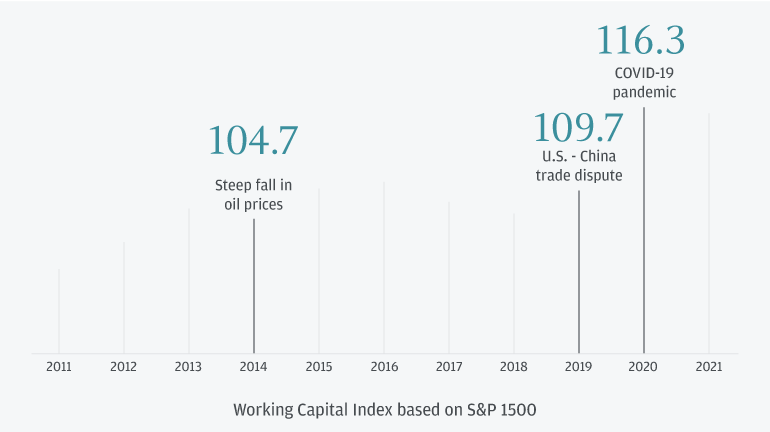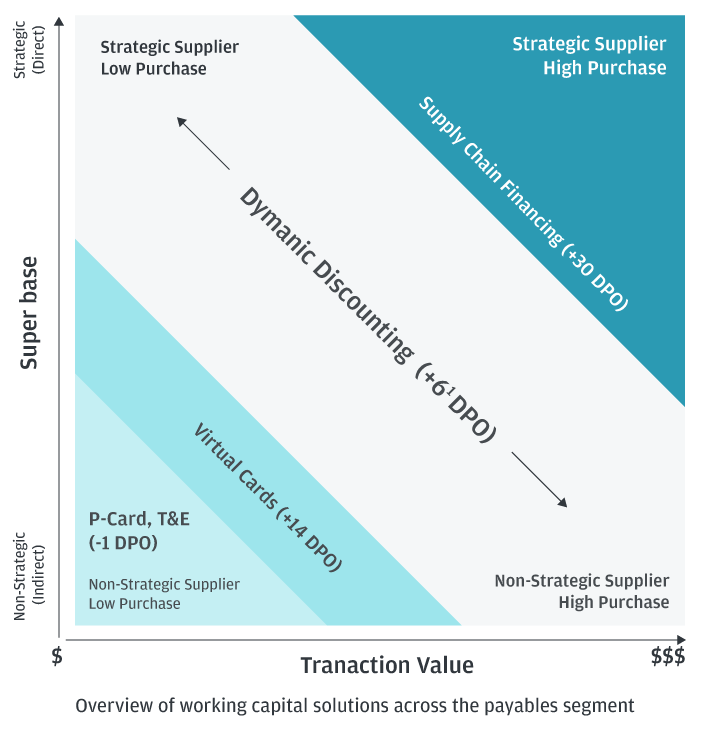The optimal payables strategy is driven by a fine balance between supplier segmentation, payment acceptance and a volume vs. value equation. We are now seeing corporates establish a holistic approach to payables management through a combination of solutions such supply chain finance, dynamic discounting, and virtual or physical cards. Each solution deployed to a specific segment of the supply chain can deliver more appropriate value transfer to respective stakeholders.

Over the past 12 months, the onset of the global pandemic has increased the focus on cash visibility and working capital management. Treasurers have had to adapt to sudden supply chain disruptions in addition to using short-term sources of internal and external liquidity to sustain operations.1 In fact, the working capital needs of corporates across industries have increased due to macroeconomic events fueled by the pandemic.
J.P. Morgan’s Working Capital Index2 rose significantly in 2020, reaching its highest level in nine years. This sharp rise was visible across 15 out of the 19 industries analyzed, which experienced longer cash conversion cycles despite an increase in days payable outstanding (DPO) largely driven by holding more inventory on balance sheets.

In this article we cover three trends, strategies and best-practice use cases that are influencing treasurers to create a more holistic approach to achieve their working capital objectives.
Three trends driving working capital strategy
As the global economy transitions through various phases of the pandemic, treasurers are proactively reviewing and future-proofing their working capital strategy in line with three key trends:
- Growing interest in optimizing supply chain management across both strategic suppliers that are critical to value creation, as well as small-to-medium supplier segments.
- Many multi-national corporates acknowledge the benefits of centralized treasury functions, enhanced visibility and operational efficiency in deploying working capital where it’s needed.
- Aligned to the 2015 Paris Accord, there is growing momentum among corporates toward net zero targets, prompting the need to review the carbon footprint of their supply chains.
Traditionally, these aspects might have been addressed in isolation or even by different departments within an organization. However, the onset of the pandemic has led to increased cross-functional collaboration and a rapid elevation of treasury’s, procurement’s and finance’s role in navigating the headwinds.
How to benchmark your working capital
Read the 2021 Working Capital Index report for insights into the working capital performance of S&P 1500 companies over the past year.
How to future-proof your working capital strategy

The disruption to supply chains and operational difficulties in sourcing and disbursing raw materials or finished goods has prompted many buyers and suppliers to renegotiate terms to help create stickier relationships, particularly to service high-growth regions.
Towards the tail-end of the supply chain, corporates have also been relooking at ways to offset the drop in travel and entertainment (T&E) volumes by redirecting non-travel expenses to virtual cards for low-value, high-volume business-to-business payments. This blended supplier payment strategy and the relevant segments for solution adoption are illustrated in the chart.
Additionally, by reducing the time it takes for companies to process supplier invoices through accounts payable invoice automation, working capital release can be achieved more quickly through supply chain financing, and excess cash can be deployed at improved margins via dynamic discounting.
Internal hurdles have traditionally persisted within companies through a lack of key performance indicator (KPI) standardization, a shortage of resources and a divergence between treasury, procurement, and sales goals. We observe how corporate treasurers are taking a more strategic role in leading cross-divisional engagements across daily cash forecasting, cash application methods, credit management as well as e-commerce and marketplace supplier portals, accelerated by the pandemic.
Cash flow intelligence tools enable buyers to deploy their excess cash more efficiently and better match their accounts payables submission dates, all of which combined with dynamic discounting solutions could reduce their position on negative yield currencies such as EUR, CHF, DKK. Direct funding of the supply chain program could also enable greater early payment discounts and materially improve their cost of goods sold.
To enhance operational efficiencies, we see how treasurers and shared centers’ leaders leveraged invoice automation processing tools to benefit from cognitive invoicing and integrated optical character recognition capabilities in reducing errors. The ability to better read and reconcile invoices could help capture early payment discounts by accelerating invoice approval. Working capital could also be released quicker when buyers can reduce the time taken to process account payables. This allows suppliers to see and discount their invoices once available in the supply chain financing platforms while achieving an extension of overall payment terms.
An increasing area of focus for treasury is the need to operationalize and embed environment, social and governance (ESG) into their daily activities as ESG investing becomes mainstream. Supply chain finance has been a natural starting point for procurement teams in particular as they look to integrate a buyer’s sustainability goals into the stability and resilience of their supply chains.
There are currently two common approaches in terms of developing a sustainable supply chain finance program. The first approach is an “ESG-linked structure” where a sustainable section of the supply chain is earmarked for a certified sustainable supply chain finance program. This can either be in the form of a ring-fenced set of buyers that are looking to improve their ESG performance or a segment of SME small- and medium-sized suppliers such as minority-owned businesses where cost-effective financing is needed.
Alternatively, in a “tiered pricing” approach, a larger scope of the supply chain is included in the total spend. As such, the pricing methodology is structured in a way that incentivizes suppliers to obtain an ESG rating and qualify for incremental discounts if they score highly on their ESG assessment. For companies that may not currently be rated highly on their ESG scorecard, any incremental fees captured as premiums can be reinvested into environmental protection programs, social development initiatives and company foundations to create a net zero outcome and continue advancing the company’s sustainability goals.
When you measure your suppliers ESG performance against an external rating framework and develop scorecards to visualize and track performance, this can help ensure supplier resilience. Meanwhile, you can manage Scope 3-related climate risks beyond the direct purview of your products and processes.
Three working capital best-practice examples
-
Optimizing working capital with virtual card
A U.S.-based manufacturer aiming to optimize working capital realized that a one-size-fits-all solution would not be practical across its entire supplier base. J.P. Morgan launched terms standardization with supply chain finance for strategic suppliers domestically, expanding the scope of payables with virtual cards. This solution extended terms on $1.5 billion of spend, and it progressively captures up to $5 billion in total spend, which provides the client with multiple channels to expedite receipt of payments for its most strategic opportunities. Converting spend to virtual cards helped maximize rebates and encourage collaboration and joint governance to think about suppliers holistically.
-
Making supplier payment processing more efficient with virtual card
A global company with headquarters in Europe that specialized in construction and transportation infrastructure management was looking for solutions to optimize their supplier payables processing. J.P. Morgan presented and innovative proprietary closed-loop solution to grow business-to-business virtual card acceptance, which addresses the main challenges around costs, manual processing and reconciliation. The solution provides all-in customized pricing for the supplier with one rate and no additional fees in exchange for open acceptance of J.P. Morgan virtual cards. Furthermore, it provides competitive rates covering all supplier segments with end-to-end visibility by automatically delivering remittance details back to the customer’s ERP system.
-
Overcoming disruption with supply chain financing and dynamic discounting
An Asian tire manufacturer with a significant presence in the EMEA region had a working capital optimization need due to major supply chain disruptions from the global pandemic. J.P. Morgan combined a supply chain financing and dynamic discounting solution via its strategic alliance with Taulia, allowing for working capital improvements, extended payment terms and an improved yield. With this solution, the business can seamlessly switch between supply chain financing and dynamic discounting as its working capital needs evolve
Take the next steps to optimize your working capital
A combination of internal and external drivers fueled by the pandemic are creating a renewed focus on working capital optimization, payables efficiency and future-proofing supply chains. This requires balancing short-term financial objectives with long-term sustainability ambitions across the organization. Treasury is best positioned to champion this evolution.
As your business explores the concepts presented in this article, you don’t have to do it alone. We are committed to helping you on your journey and crafting tailored solutions to meet your needs along the way.
Connect with your J.P. Morgan representative to get started today.
References
Not all products and services are available in all geographic areas. Eligibility for particular products and services is subject to final determination by JPMC and or its affiliates. This material does not constitute a commitment by any JPMC entity to extend or arrange credit or to provide any other products or services and JPMC reserves the right to withdraw at any time. All services are subject to applicable laws, regulations, and applicable approvals and notifications.
The views and opinions expressed herein are those of the author and do not necessarily reflect the views of J.P. Morgan, its affiliates, or its employees. The information set forth herein has been obtained or derived from sources believed to be reliable. Neither the author nor J.P. Morgan makes any representations or warranties as to the information’s accuracy or completeness. The information contained herein has been provided solely for informational purposes and does not constitute an offer, solicitation, advice or recommendation, to make any investment decisions or purchase any financial instruments, and may not be construed as such.
JPMorgan Chase Bank, N.A. Member FDIC
JPMorgan Chase Bank, N.A., organized under the laws of U.S.A. with limited liability.







